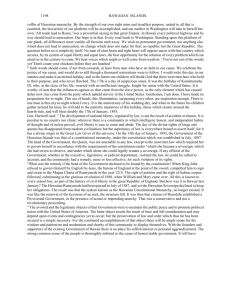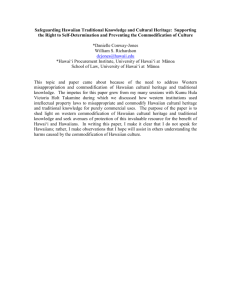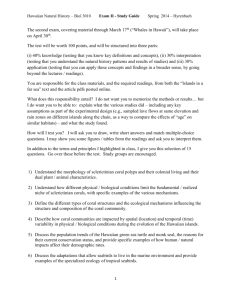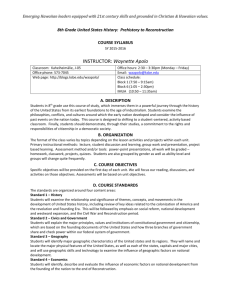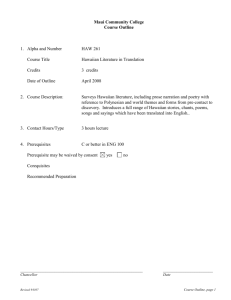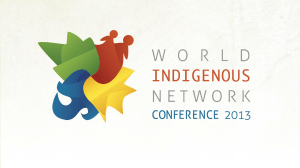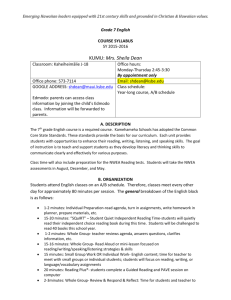Hawaiian Children`s Developmental understanding
advertisement
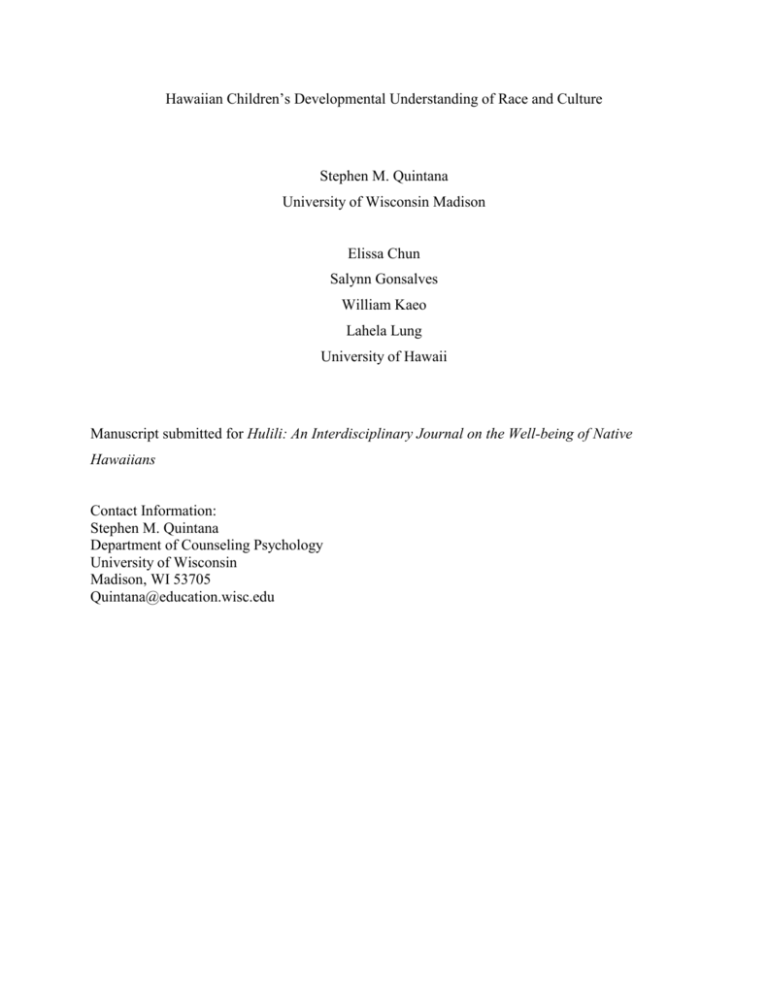
Hawaiian Children’s Developmental Understanding of Race and Culture Stephen M. Quintana University of Wisconsin Madison Elissa Chun Salynn Gonsalves William Kaeo Lahela Lung University of Hawaii Manuscript submitted for Hulili: An Interdisciplinary Journal on the Well-being of Native Hawaiians Contact Information: Stephen M. Quintana Department of Counseling Psychology University of Wisconsin Madison, WI 53705 Quintana@education.wisc.edu Kamehameha Schools Research Conference Quintana et al. 1 Abstract Native Hawaiian children were administered an open-ended interview about their understanding of ethnicity and culture. In total, 58 Native Hawaiian children participated from grades 3 – 6 from one private and two public elementary schools. Children’s responses were consistent with model of children’s ethnic perspective-taking ability. Preliminary statistical analyses indicated that children’s age and exposure to Hawaiian culture predicted their level of development for understanding ethnicity and culture. Kamehameha Schools Research Conference Quintana et al. 2 Hawaiian Children’s Developmental Understanding of Race and Culture Introduction We are realizing that children’s racial and cultural identities are critically important to their well-being as well as their psychological and educational adjustment. For decades, researchers and others worried that racial stigmatization would lead children to feel bad about themselves—that is, have low self-esteem. These concerns were influential in the landmark Supreme Court case Brown vs. Board of Education of 1954, which lead to school desegregation. Unexpectedly, researchers found more recently that some stigmatized children show higher not lower self esteem, relative nonstigmatized children, adolescents, and adults (Crocker and Major, 1989). Although these findings provided some reassurance that stigmatized children’s racial identities do not appear to influence their self-esteem, other recent research (see Wheeler & Petty, 2001 for a review) has again created new, arguably more serious, concerns about the deleterious effects of stigmatization on children’s ethnic and racial identities. Recent research has found that stigmatized children, adolescents, and adults may be vulnerable to stereotype threat effects that may significantly handicap their performance on academic tests (Wheeler & Petty, 2001). Under stereotype threat conditions, a person who has been stigmatized underperforms on academic tests, relative to their performance in non-threat conditions. The stereotype threat conditions exist when the person’s racial status has been made salient. The conditions that have elicited stereotype threat have been as simple as asking the person to report their racial status on a demographic form, which is common practice in many testing situations. The stereotype threat conditions are believed to be active because the person’s stereotypes about his or her racial group become activated and then are applied to the self (Wheeler & Petty, 2001). Quintana and Herrera-Segura (2003) have suggested that stigmatized children may develop a false consciousness about themselves and their racial group, in which they may internalize the stereotypes about their racial group. They suggested the stereotype threat conditions may activate this false consciousness and then the children apply this false consciousness to themselves. Quintana and Herrera found evidence of this false consciousness in racial identity interviews with stigmatized native children in Guatemala. Elsewhere, Quintana, Vera, and Cooper (1999) found that children’s racial identity and attitudes were key to their openness and comfort with interacting with members of other racial Kamehameha Schools Research Conference Quintana et al. 3 groups. Many believe that in order to produce positive inter-racial relations, racial group membership should be minimized (Pettigrew, 1998). However, Quintana et al. found that stigmatized minority children (African Americans) who had low levels of racial pride preferred to interact only with members of their same racial group. Conversely, those children who had the most positive racial identity and pride were most open to interacting with members of other racial groups. Taken together, research suggests that children’s racial identity is critical to their adjustment in an increasingly diverse society. The purpose of the present study is to examine Native Hawaiian children’s racial identity by exploring how they understand their psychological significance of their racial group membership. Applying this research to native Hawaiian children seems particularly important given Andrade’s (2003) finding that an emphasis on Hawaiian culture was more strongly associated with mental health problems for Hawaiian adolescents. How children understand race, ethnicity, and culture is very similar to how they understand other aspects of their social world. Hirschefeld (1995) indicated that children’s understanding of the biological nature of race was associated with their naïve theories of biology. For example, children’s understanding of the permanence of racial phenotype—such as skin, eye, and hair color—was associated with children’s understanding of the stability of biological characteristics (Hirschefeld, 1995). Similarly, Quintana (1998) suggested that children’s social cognitive abilities, or their understanding of the social world, was associated with their understanding of ethnicity and culture. Quintana and colleagues have investigated children’s understanding of race and ethnicity for eight distinct groups, including Mexican American, African American, Caucasian/White American, International sojourners to United States, Transracially adopted Korean, and two racial groups in Guatemala (Ladinos and Quichés). This research has found that children appear to apply their social cognitive understanding of the social world to understand ethnicity and race (Quintana, Ybarra, Gonzalez-Doupe & de Baessa, 2000; Quintana, Castaneda-English & Ybarra, 1999). Moreover, this research has found that although the general rhythm of development across these different racial and ethnic samples appears consistent, there are important variations due to socio-cultural context that influence children’s ethnic and racial understanding (Lee & Quintana, 2003; Quintaan & Vera, 1999; Quintana & Segura-Herrera, 2003). Kamehameha Schools Research Conference Quintana et al. 4 The purpose of the present study was to apply this framework to Native Hawaiian children’s understanding of race and ethnicity. We were interested in learning if the framework would be applicable to this population and to determine what variations in the development would be associated with the sociocultural context of Native Hawaiian children. Specifically, the children of color in the United States investigated in previous research were numerical minorities in the presence of a numerically and politically dominant group. Similarly, children in previous research were in a fairly segregated context in which they had relatively little interaction with other minority ethnic groups. In contrast, the ethnic and racial demographics of Hawaii, O‘ahu specifically, involve significant diversity with no numerically dominant group (i.e., over 50%) and exposure to a wide diversity of ethnic and cultural groups. Moreover, the prevalence of inter-ethnic marriages in Hawaii resulting in children with biracial/bicultural and, more typically, multicultural heritages makes this context particularly valuable in investigating variations in the content of children’s ethnic and racial understandings. Methods Participants A total of 58 Native Hawaiian children participated in the study. Participants were recruited from two public schools, one in Honolulu (N=15) and the other in Kane’ohe (N=15), and one private school in Honolulu (N=28). Children were recruited from grades 3 – 6. A prerequisite for participating is that children were of Native Hawaiian heritage. In the public schools, eligible children were identified by school counselors. All of the children from the private school were eligible. Table 1 lists the demographic background of the participants in the study. The number of participants per grade was 10, 18, 17, and 13 for grades 3 through 6, respectively. Table 2 lists the self-reported Hawaiian customs and cultural activities as well as number of children exposed to Hawaiian language by members of the family and relatives. Instruments Interview. Children were individually administered interviews (see Appendix) to assess their understanding of ethnicity and culture by Native Hawaiian adults (3 interviewers were female, 1 was male) who all had previous training in working with children and, with Native Hawaiian children specifically. The interview was designed to probe children’s logic and Kamehameha Schools Research Conference Quintana et al. 5 understanding of culture based on their personal experiences, observations, and thoughts about social situations involving Hawaiians. Drawings were created to represent Native Hawaiians, including drawings of a boy, girl, family of four, and three groups (one group was drawn to have only Naïve Hawaiians, one group had only Caucasians, and the third group had a mixture of ethnic persons represented). Illustrations representing Caucasians in parallel situations from a previous research project were used. The illustrations were used to help children understand and visualize the interview questions. The interviewer was able to manipulate the drawings in order to visually represent the questions and issues being addressed. The drawings were also used to maintain children’s interest and engagement in the interview. As in previous research, the child’s cultural group was contrasted with another comparison group. And, as in previous research, Caucasians was the comparison group. Native Hawaiian Customs and Activities Questionnaire. Two subscales from Hishinuma et al.’s (2000) Hawaiian Culture Scale were used in the present study: Customs and Beliefs and Activities and Social Events. These two subscales consistently revealed significant validity coefficients in the Hishinuma et al. study. Moreover these subscales appear to parallel previous measures of cultural knowledge and exposure used in previous research (Quintana et al., 2000). Within this study, the two subscales combined had an internal consistency coefficient (alpha) of .84, separately the subscales had alpha coefficients of .80 and .79, respectively. Validity coefficients for these two subscales obtained within the present study were strong (e.g., r = .45 and .57, ps<.001) based on relationships with child’s use and understanding of Hawaiian language. The two subscales had a strong inter-correlation (r = .49, p <.001). Demographic and other cultural variables. Additional information about child’s grade, birthdate, gender, exposure to Hawaiian language at home and main sources of exposure to Hawaiian language were also collected from children. Examples of some of this background information is provided in Table 2. Procedures Parental permission and consent were obtained before children participated. In the two public schools parental consent forms were sent home with children who were identified by Kamehameha Schools Research Conference Quintana et al. 6 school counselors as being eligible to participate in the study. Children who had parents consenting to their participation completed assent forms—these forms were administered by school counselors. Participating children in the public schools were individually interviewed at the school (e.g., school counselor’s office). For participants in the private school, parental consent forms were mailed to parents. Parents consenting to their children’s participation signed and mailed the form back to the interviewers. Upon receipt of consent forms, interviewers contacted parents to schedule a convenient time for the child and parent for the interview. Interviews were conducted in children’s homes for the private school. Interviews were audiotaped. The order of administration was that the open-ended interview was conducted before the administration of the questionnaire as we were concerned that completing questions about Hawaiian customs and activities might influence children’s responses to open-ended questions in the interview. Results and Discussion The results suggested that Quintana’s (1998) model of ethnic perspective taking ability (EPTA) could be applied to Hawaiian children. As would be expected with the age distribution of the sample, four levels of EPTA were detected. Level 0: Physical and Observable Perspective of Ethnicity and Culture Young children tend to construe their social world based on their observations of the more obvious physical features (Selman, 1980). For example, when asked How do people change as they get older? Young children respond by describing physical changes: They get bigger… their shoes are bigger… they talk louder, etc. Similarly, when asked to describe a good friend, young children will often describe a friend who is physically close (e.g., a next door neighbor). And, when asked what makes a group good, young children will often suggest that a physically big group is good. Children seem to confuse physical appearance with the essence of social action (Selman, 1980). For example, young children may believe that people are happy because they smile, instead of people smiling because they are happy. To make a person happy, young children may suggest that you make the person smile. In this last example, the physical, Kamehameha Schools Research Conference Quintana et al. 7 external manifestation (smile) is confused within the internal state (feeling happy). Similarly, children may believe people are sad because they are crying, rather than vice versa. Children appear to apply this physical perspective to understanding ethnicity and race. In the present study, Hawaiian children understood Hawaiian ethnic/cultural status based on physical, observable, and some young children also had some confusions about what it meant to be Hawaiian. At this level there is awareness of physical features such as skin and hair coloration and observable characteristics such as speaking Hawaiian that the children associated with being Hawaiian. Some young children revealed some confusion with being Hawaiian as a resident of the State and being Hawaiian based on culture or ancestry. Some children at this level might believe a person becomes Hawaiian (or other ethnic/racial groups) by speaking the language or living in the State. Interviewer: How else do you know you are Hawaiian? Child: Another way I can tell is when I go to school and when I go to sleep my skin color is brown. Because when it is white, if I was born that way then maybe then I’d be White. Interviewer: Can you ever stop being Hawaiian? Child: No, I don’t think so…. oh yeah. By going to live somewhere else like Wyoming. Interviewer: Why might someone not like being Hawaiian? Child: They may not like being Hawaiian because they are Japanese and speak some other language. Interviewer: How are Caucasians and Hawaiians different? Child: You can tell the difference, the Caucasians are kind of white in skin color and the Hawaiians are like tanish brown, not white. Interviewer: How can you tell if someone is Hawaiian or not? Child: Like if they have yellow hair than you can tell [that they are not Hawaiian]. Kamehameha Schools Research Conference Quintana et al. 8 There appears to be two sublevels of the physical and observable perspective of ethnicity with the first sublevel (sublevel 0a) being among the least mature children as indicated by difficulties using adult classifications of ethnicity and culture, along with some sources of confusion indicated above. At the next sublevel (sublevel 0b), children can accurately and reliably differentiate ethnic differences (e.g., between Native Hawaiians and Caucasians), but they remain focused on observable and physical features. At this sublevel, children mention their ethnicity being determined by parents or official documentation (e.g., birth certificates). For these children, there may be an implicit sense that if they were told differently (or documentation was different) then they would have a different ethnic status. In other words, children’s understanding of status beyond the physical features or official declaration is not well established at this level of development. An example of sublevel 0b are below. Interviewer: How do you know you are Hawaiian? Child: It says that [Hawaiian] on my birth certificate. Another Child: My Mom told me I was. In the present sample, only the youngest members of the sample (third graders) with relatively little cultural exposure to Hawaiian customs and cultures (as revealed by scores on the Hawaiian Cultural subscales) were classified at this early level of development and some of these were classified as being at a transition point between EPTA level 0 and EPTA level 1. Level 1: Literal Perspective of Ethnicity and Culture As young children mature they are able to differentiate their observations of physical appearances and can infer underlying psychological characteristics (Selman, 1980). At this level, children understand that people smile because they are happy and people cry because they are sad—the unobservable psychological states (of happiness or sadness) underlie the physical expression (i.e., smiling, crying) of these states. Children at this level may recognize that a good friend is not necessarily someone who lives nearby but who has some positive psychological characteristics (e.g., is nice, friendly, likes the same things the child does etc.). Moreover, there is recognition that as people grow older, they change not only physically but also psychologically (e.g. “grown-ups think about or like different things than kids do”). At this level, children’s Kamehameha Schools Research Conference Quintana et al. 9 ability to infer psychological characteristics is nascent and they tend to be literal in their inferences about psychological states from physical appearances. For example, although children at this level recognize that external physical appearances are not the same things as internal psychological states, they seem naïve in assuming that appearances are good predictors of internal states. They may wonder, for example, why someone would smile when they weren’t happy. In short, there is a literal quality to children’s perspective-taking ability (Quintana, 1998). Responses from some Hawaiian children confirmed that some were applying a literal perspective to their understanding of Hawaiian ethnicity and culture. At this level, there is an emphasis on those features that are literally connected to being Hawaiian (e.g., those things that are labeled Hawaiian, such as the language, the State, apparel, dance, etc.). There is a beginning awareness of some internal or psychological characteristics associated with ancestry, such as preferences for food or ability to acquire cultural skills such as perform Hula or carve wood statues. At this level, children appear to understand clearly that ethnic status is fixed, determined by heritage. Understanding of ethnicity and culture, however, remains fixed on nonsocial, somewhat abstract aspects of ethnicity directly connected to Hawaiian culture ancestry (e.g., ancestors from ancient Hawaiians, traditional foods and customs, etc.). There is a tendency at this level to view ethnicity as an artifact of the past and not to mention implications of ancestry for everyday life, except for some special ethnic events (cooking Hawaiian food, celebrating Hawaiian holidays, practicing ancient Hawaiian custom). The following are excerpts that are consistent with level 1 understanding of ethnicity and culture. Interviewer: How do you know you are Hawaiian? Child: I know I’m Hawaiian because whenever I learn new Hawaiian words I can really speak it. Child: I know I’m Hawaiian because I live in Hawaii and I wear Hawaiian clothes Interviewer: Why do you like being Hawaiian? Child: It’s cool to be Hawaiian because the language is cool and stuff they did way back is cool. Kamehameha Schools Research Conference Quintana et al. 10 Interviewer: How do you know you are Hawaiian? Child: Cause my grandma is Hawaiian and my dad is half of that and I am half of that. Child: Cause my mom is Hawaiian and she got her Hawaiian from her dad and her mom. Child: My grandpa knows how to cook real Hawaiian kinds of food and like when he was younger I guess he learned from his parents old Hawaiian food. These excerpts illustrate the emphasis given to literal features of ethnicity and culture for children’s understanding of Hawaiians at this level of perspective-taking ability. It is important to note that as children progress to new developmental levels they do not lose the perspectives (e.g., physical perspective) characteristic of younger children. Each new level corresponds to the addition of a new perspective that supplements previous perspectives. That is, children using a literal perspective of ethnicity and culture maintain awareness of physical features of ethnicity and culture. Consequently, children at level 1 are differentiated from those at level 0 because they can also assume a literal perspective of ethnicity whereas children at level 0 cannot. Level 2: Nonliteral and Social Perspective of Ethnicity and Culture As children progress through elementary school their ability to construe social situations increases. Moving beyond a literal perspective they begin to understand the social dynamics involved in their social world. A friend is seen not only as someone that is nice or friendly, but as someone who likes the child. That is, children at the next level of development understand the importance of reciprocity in friendships—good friends like each other. Similarly, a good group is more than just a collection of people that might like the same activities (characteristics of Level 1), but also like each other as well. Social situations are now better construed in terms of the meaning and function of social behavior (Selman, 1980). It is understood more clearly at this level why, for example, someone might smile even if not happy: the smiling may have a social function and not be simply be a reflection of an internal state. There are two main implications for children applying a social perspective to their ethnic and cultural worlds. Specifically, children move beyond a more literal view of ethnicity and culture and are able to detect some subtle features that are not literally connected to ethnicity and culture. They may notice, for example, there are social class differences among ethnic groups Kamehameha Schools Research Conference Quintana et al. 11 that go beyond a literal or dictionary-like definition of ethnicity used by children at Level 1. The second implication is that children apply a social perspective to understanding ethnicity and inter-ethnic relations. That is, they are better able to understand the social dynamics of prejudice and discrimination. More generally, differences between ethnic groups are not based on the practice of customs handed down through the generations (i.e., artifacts of the past) but may include various mundane social behaviors. Ethnicity and culture is not seen as artifacts of the past (as was reflected in level 1), but have important implications for contemporary social interactions (Quintana, 1998). The following are responses illustrating an awareness of subtle and social features associated with ethnicity and race from Hawaiian children. Interviewer: How are Hawaiian families different from Caucasian or White families? Child: Maybe the[Hawaiian] parents would sing him to sleep and in the White family they might just say ‘good night’ and turn off the light. Interviewer: What does it me to be Caucasian or White? Child: It means to be different from us. They might have been wealthier than we [are] and they probably had more things. Child: Hawaiians are really kind and loving…and when they dance its like real nice they actually show you what the song is about with their hand motions. Interviewer: How do you know if someone is Hawaiian or not? Child: Because I realize when I talk to Caucasian people some of them aren’t that…friendly…but like pure Caucasians…Well I don’t meet them a lot. Child: I can tell [if a person is Hawaiian] by the way they talk. Child: Because if another person [a Caucasian] met someone who was Hawaiian the Hawaiian might talk pidgin a little bit and they might say ‘you’re not speaking right, you’re weird.’ and start teasing you and stuff These examples reveal that Hawaiian cultural differences are not simply abstract characteristics but also have important social functions with either inter- or intra-group relations. At this level Kamehameha Schools Research Conference Quintana et al. 12 children operate more like sociologists in their discovery of behavior and activity that are associated with ethnic group membership than in previous levels of development. Level 3: Group Perspective of Ethnicity As youth move into early adolescence their social cognitive skills mature in one particularly important way. They can generalize across isolated or discrete events and thereby posit generalized characteristics and tendencies (Selman, 1980). This has two important implications for their perspective of the social world. First, they can generalize across discrete experiences and abstract patterns and tendencies from discrete behaviors. Secondly, youth at this level of development can abstract generalized group characteristics from members of a group. In a sense they can conceptualize a generalized group perspective on social events (e.g., suggesting the group responds collectively to an event such as when one member is insulted). These social cognitive skills are associated with youth’s increased stereotyping of others based on generalizations (sometimes over-generalizations) about peers based on a few isolated social events and the formation of peer cliques, in which there is conformity to perceived group norms. At this level, a good group is one with a sense of espirit de corps in which there is an all-for-one and one-for–all orientation. A good friend is not only someone who likes the youth, but also demonstrates loyalty to the friendship over time. Youth tend to understand individuals by positing trait characteristics (e.g., one peer is cool, another a nerd, etc.) representing generalizations of patterns of behavior. The application of this social perspective taking to children’s understanding of ethnicity and culture reveals two sublevels. The first level (sublevel 3a) is the ability to understand the impact of pervasive experiential influences associated with ethnicity. For example, youth understand that the history of inter-racial relations between Whites and Native Hawaiians can affect contemporary inter-racial interactions between individuals. The second sublevel (3b) involves the merging of ethnic identity with a personal identity. There may be the tendency to use the pronouns of “us” and “we” when referring to a group rather than referring to groups as discrete members (as was characteristic of level 2), using him/her or them when referring to their own group. Characteristic of this level is the accentuation of in-group similarities and Kamehameha Schools Research Conference Quintana et al. 13 conformity to in-group norms. The following excerpts are examples of this level of EPTA from interviews with Hawaiian children. Interviewer: How are Hawaiians and Caucasians different? Child: Because earlier in MLK day, the Whites wouldn’t agree with the Hawaiians and Blacks and use them as slaves…if we were in those days right now we would be scrubbing someone’s floor or digging someone’s weeds and doing a lot of stuff and slaving and working really hard. Interviewer: Do you like being Hawaiian? Child: Being Hawaiian is fun because you get to learn more than if you…cause if you are in this school, you get to know about your culture and religion and how you are supposed to live. It gets me to know myself a little better Interviewer: What does it mean to be Hawaiian? Child: Having pride in being Hawaiian. Interviewer: Which team (all Hawaiian, all White, or Mixed reams) would the Hawaiian girl choose to join? Child: She would pick the all Hawaiian team because she could connect better because they have the same experiences. Conclusions Preliminary coding of interviews suggest that children’s level of ethnic perspective-taking development was strongly predicted by their age (r = .51) and level of cultural exposure (r =.66), as reflected on scores from the Hawaiian Culture Subscales. These findings along with interview responses suggest that the EPTA model can be applied to the Native Hawaiian population. Moreover, preliminary results (Quintana, 2004) suggested that children who attended a private school that emphasized Hawaiian ethnic identity and history had significantly higher scores on the cultural exposure measure and on the EPTA scores. Subsequent analyses suggested that the private Kamehameha Schools Research Conference Quintana et al. 14 school’s curriculum produced elevations in children’s cultural exposure and that this increase in cultural exposure was associated with the higher EPTA scores—that is, the cultural exposure mediated the relationship between private school and higher EPTA scores. An important implication is that educators could use this model to develop interventions and programs that could be sensitive to the different developmental levels for Hawaiian children. At early elementary grades, teachers may wish to emphasize discussion of physical manifestations of ethnicity and culture, but also encourage children to think about the cultural characteristics that are obviously connected to Hawaiian culture. During middle elementary school, children appear to understand that ethnicity and culture have implications for everyday, mundane social interactions and this understanding comes with an increased awareness of ethnic discrimination and prejudice. Finally, as Hawaiian youth approach adolescence, it may be helpful for educators to recognize that, for some youth, their ethnic identity takes on increased personal importance. Table summarizes the levels and sublevels of EPTA for Hawaiians. The model depicted in Figure 1 represents a characterization of the study findings as reflecting the influence of cognitive maturation and cultural exposure to the development of Hawaiian children’s understanding of their ethnicity and culture. References Andrade, N. (2003). Prevalence of Mental Disorders in Native Hawaiian Adolescents using the NIMH diagnostic interview schedule for children. Symposium presentation at the Kamehameha Schools’ Inaugural Research Conference on the Education and Well-being of Hawaiians. O’ahu, Hawaii, September 18 – 20, 2003. Crocker, J. & Major, B. (1989). Social Stigma and self esteem: The self-protective properties of stigma. Psychological Review, 96, 608-630. Hirschfeld, L. A. (1995). Do children have a theory of race? Cognition, 54, 209-252. Lee, D. C. & Quintana, S. M. (2003). The importance of cultural exposure to understanding race for transractially adopted Korean children. Manuscript submitted for publication Kamehameha Schools Research Conference Quintana et al. 15 Hishinuma, E. S., Andrade, N. N., Johnson, R. C., McArdle, J. J., Miyamoto, R. H, et al. (2002). Psychometric properties of the Hawaiian Culture Scale—Adolescent version. Psychological Assessment, 12(2), 140 – 157. Pettigrew, T. F. (1998). Intergroup contact theory. Annual Review of Psychology, 49, 65 – 8. Quintana, S.M. (1998). Development of children's understanding of ethnicity and race. Applied & Preventive Psychology: Current Scientific Perspectives, 7, 27-45. Quintana, S. M., Castañeda-English, P. & Ybarra, V. C., (1999). Role of perspective-taking ability and ethnic socialization in the development of adolescent ethnic identity. Journal of Research on Adolescence, 9, 161-184. Quintana, S. M. & Segura-Herrera, T. (2003). Developmental transformations of self and identity in context of oppression. Journal of Self and Identity. 2, 1 – 17. Quintana, S. M., Vera, E., & Cooper, C. (August, 1999). African-American children's racial identity and inter-racial coping strategies. Poster presentation at the annual convention of the American Psychological Association, Boston, MA. Quintana, S. M., Ybarra, V. C., Gonzalez-Doupe, P., & de Baessa, Y. (2000). Cross-cultural evaluation of ethnic perspective-taking ability in two samples: US Latino and Guatemalan Ladino children. Cultural Diversity and Ethnic Minority Psychology, 6, 334-351. Quintana, S. M. & Vera, E. (1999). Mexican-American children's representations of ethnic prejudice. Hispanic Journal of Behavioral Sciences, 21, 387-404. Selman, R. L. (1980). The growth of interpersonal understanding: Developmental and clinical analyses. San Diego, CA: Academic Press. Kamehameha Schools Research Conference Quintana et al. 16 Wheeler, S. C. & Petty, R. E. (2001). The effects of stereotype activation on behavior: A review of possible mechanisms. Psychological Bulletin, 127, 797-826. Kamehameha Schools Research Conference Quintana et al. 17 Table 1 Demographic information on participants Age Mean (SD) 9.57 (1.11) Male 24 41.4% Female 34 58.6 Public (N=2) 30 51.7% Private (N=1) 28 48.3% Hawaiian 58 100% Chinese 45 77.6% Japanese 28 48.3% Portuguese 25 43.1% Filipino 20 34.5% White/Caucasian 20 34.5% Korean 8 13.8% Sex School Ancestry Note: Percentage column for Ancestry does not sum to 100% because children were bi-racial or multi-racial. Kamehameha Schools Research Conference Quintana et al. 18 Table 2: Summary of Levels and Sublevels for EPTA of Hawaiians Level 0: Physical and Observable Perspective Sublevel 0a: Idiosyncratic terminology used and some idiosyncratic understanding of race and ethnicity. Sublevel 0b: Increased accuracy in classifying races and ethnicities based on observable features. Level 1: Literal Perspective Sublevel 1a: Beginning understanding of some of the relatively permanent, nonobservable aspects of ethnicity (e.g., cultural history, food preferences). Sublevel 1b: Conception of the heritage or ancestry components of ethnicity. Level 2: Nonliteral and Social Perspective of Ethnicity Sublevel 2a: Awareness of subtle aspects associated with ethnicity not directly tied to ancient Hawaiians or Hawaiian culture (e.g., Social class issues). Sublevel 2b: Integration of everyday, mundane social experiences related to ethnicity and awareness of ethnic prejudice. Level 3: Group Perspective of Ethnicity Sublevel 3a: Awareness of the impact of pervasive experiential influences associated with ethnicity Sublevel 3b: Ethnic group consciousness. Kamehameha Schools Research Conference Quintana et al. 19 Figure 1: Model of Children’s Development of Ethnic and Cultural Understanding INFLUENTIAL FACTORS DOMAINS OF UNDERSTANDING Cognitive Maturation Intra-ethnic Relations Hawaiians Cultural Exposure Whites/ Haoles Inter-ethnic Relations Kamehameha Schools Research Conference Quintana et al. 20 Appendix: Understanding of Hawaiian Interview CHILD INTERVIEW Introduction: I am going to ask you some questions. There are no right or wrong answers and you won't get a grade for your answers to these questions. I am interested in your opinions about these questions. I want you to think about each question very carefully. If you don't understand and need me to repeat the question, let me know. Ethnic Label Test I am going to say some words and after I say each word, I want you to tell me whether the word is about you. Are you _________? (repeat for each word below) 1. Samoan 9. American 2. Caucasian 10. Vietnamese 3. Japanese 11. Korean 4. Hawaiian 12. White 5. African American 13. Hapa 6. Filipino 14. Tongan 7. Chinese 8. Portuguese Out of all the words you said describe you, which is the word or words that you use most often? (continue to use the same word/s as used by the child to describe themselves throughout the interview) Which terms do you use to describe people who are White or Caucasian? Individual Domain Kamehameha Schools Research Conference Quintana et al. 21 [SHOW PICTURES OF THE FOUR CHILDREN] Here are some pictures of four children about your age. Some of these boys and girls are Hawaiian [USE LABEL CHILD SELECTED] and some are Caucasian (or not Hawaiian). Which ones are Hawaiian? Which ones are Caucasian (or not Hawaiian)? [REMOVE THE TWO PICTURES OF THE CHILDREN THAT ARE OPPOSITE GENDER OF CHILD] This child is Hawaiian. What does it mean to be Hawaiian? What else does it mean to be Hawaiian? [PROBE FOR AS MANY ANSWERS AS CHILD IS CAN OFFER] This child is Caucasian/white/not Hawaiian. What does it mean to be Caucasian/white/not Hawaiian? You said you were Hawaiian. How do you know you are Hawaiian.? How else do you know you are Hawaiian? [PROBE FOR AS MANY ANSWERS AS CHILD CAN GIVE] Do you like being Hawaiian? Why or Why not? [PROBE] Do you ever wish you were not Hawaiian? Why or why not? Why would someone not like being Hawaiian? Can you ever stop being Hawaiian? How? or Why not? Friendship Domain Now I am going to ask you some questions about friendship. [SHOW TWO PICTURES OF SAME GENDER] We're going to pretend that these two boys/girls are new to your school and have been put into your class, OK? Which child would you like to be friends with? Why? [it is okay if child says ‘both’] Do you have any Hawaiian friends? What are their names? Kamehameha Schools Research Conference Quintana et al. 22 How do you know if a person is Hawaiian or not? Do you like having Hawaiian friends? Why? Why not? Are there any advantages to having Hawaiian friends? Are there any disadvantages? Do you like having friends who are not Hawaiian? Why? Why not? Are there any advantages to having friends who are not Hawaiian? Are there any disadvantages? Do you do different things with friends who are not Hawaiian than with Hawaiian friends? If so, what? Do you talk about different things? Why might some people not like Hawaiians? [Probe for as many responses as child can give] Group Domain Do you remember this drawing (show the Hawaiian child) Here are three soccer teams. This team has only Hawaiian boys/girls, this team does not have anybody who is Hawaiian, and this team has some Hawaiian, African American, and some White or Caucasians. Out of the three teams I have shown you, which team do you think this Hawaiian, boy/girl would choose? Why would he/she choose that team? Which team to you think this White (or Caucasian) child would choose? Why? Which team would you choose? Is there any advantage for a Hawaiian child be in a group that is all Hawaiian? Is there any disadvantage? Any advantage for Hawaiian child being on all Caucasian group? Any disadvantage? Kamehameha Schools Research Conference Quintana et al. 23 Any advantage to being on the Mixed group? Any disadvantage Now let's pretend that this Hawaiian boy/girl were to join this team [POINT TO CAUCASIAN TEAM]. Sometimes a group will single out one person to tease, blame or call names even though it's not their fault. This boy/girl is being teased by the other members of the team because she is Hawaiian. Why do you think this sort of teasing and name calling happens? What should this child do if that happens? Some people say that people who are White have more money and have more things than Hawaiians. Why would that [have more & better things] happen? Family Domain [SHOW TWO FAMILIES] Here are pictures of two families. This family is Hawaiian and this family is Caucasian or not Hawaiian. Pretend that this child [point to the picture of the Hawaiian child] spent the night with each of the families. Let's say that he/she spent night with this [POINT TO CAUCASIAN] family. Would spending the night with the Caucasian family feel any different or be any different than spending the night at the Hawaiian family’s home? Another pretend question: Let's pretend that a boy/girl was adopted into a family just like this Caucasian/White family. Suppose this child just found out that his/her parents were Hawaiian. She knew she was adopted, but didn't know what culture her parents were. Would this change him/her? Would he/she now think of him/herself differently? How/Why/Why not? How would this person be different from someone who always knew they were Hawaiian? Kamehameha Schools Research Conference Quintana et al. 24 Are there things you and your family do because you are Hawaiian? If yes, what things?

